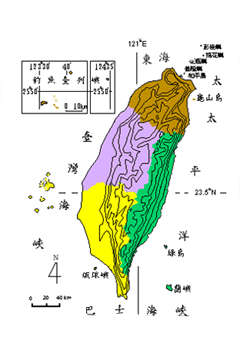The Population Geography of Taiwan

Relevant Websites
- Tai-wan-jen-kou-ji-liao-wan-zhan
- Directorate General of Budget Accounting and Statistics Ministry of the Interior
- IDB
Reference
- Chen, Cheng-shiang and Hsiao-keng Tsai, 1955: Tai-wan-jen-kou-zhi-chu-sheng-yu-shi-wang, Tai-wan-yin-hang-ji-kan, Vol. 7, no. 4, pp. 37-75.
- Chen, Cheng-shiang, 1959: Tai-wan-di-zhi-shang-che, Fu-ming-chan-ye-di-li-yan-jiu-suo, p. 400.
- Chen, Shao-hsin, 1972: Tai-wan-sheng-tong-zhi-juan-2, jen-min-zhi, jen-kou-pian, Tai-wan-sheng-wen-xian-wei-yuan-hui. pp. 1-316.
- Li, Wen-min, 1979: Tai-wan-dushi-hua-yu-jen-kou-qian-yi, Du-shi-she-hui-fa-zhan-zhi-yan-jiu, Liwen Book Co., pp. 179-195.
- Lin, I-hou, Tai-wan-jen-kou-ji-zhong-qu-shi-ji-qi-ying-xiang, Dang-qian-Tai-wan-she-hui-wen-ti, Liwen Book Co., pp. 153-168.
- Lin, Rui-sui, 1979: Tai-wan-jen-kou-zhi-liang-shang-de-yi-xie-wen-ti-ji-qi-jie-jue-tu-jing, Dang-qian-Tai-wan-she-hui-wen-ti, Liwen Book Co., pp. 169-184.
- Chen, Shao-hsin, 1979: Tai-wan-de-ren-gou-bian-qian-yu-she-hui-bian-qian, Taipei, Linking Publishing Company, p. 578.
- Cheng, Da-hsueh, 1991: Tai-wan-gai-fa-shi, Department of Information, Taiwan Province Government, p. 204.
- Shih, Tien-fu, 1982: Tai-wan-de-jen-kou-yi-dong-he-shuang-yuan-xing-fu-wu-bu-men, Department of Geography - National Taiwan Normal University, p. 160.
- Chen, Kuan-cheng and Tien-feng Yeh, 1983: Ri-ju-shi-dai-yi-lai-tai-wan-di-qu-jen-kou-nian-ling-zu-cheng-zhi-bian-qian (1905-79), Jen-kou-xue-kan, no. 6, pp. 99-114.
- Hsieh, Kao-chiao, 1983: Jen-kou-xian-dai-hua, She-hui-jing-ji-fa-zhan-yu-jen-kou-cheng-zhang, Jen-kou-xue-kan, no. 6, pp. 69-85.
- Tai-wan-di-qu-lao-dong-li-zhui-gu-yu-tiao-zheng-jie-guo-biao, Jen-li-zi-yuan-diao=cha-tong-ji-nian-bao, Directorate General of Budget Accounting and Statistics Executive Yuan R.O.C.
- Yang, Ching-li, 1997: Tai-wan-di-qu-jen-kou-jie-gou-bian-qian-de-shen-ceng-wen-ti, Zheng-ce-yue-kan, Vol. 28, pp. 2-4.
Population Growth
Taiwan was the land of the Austronesian aborigines before the Han Chinese moved in. These early residents were not many in number, so the Han Chinese have dominated Taiwan's population growth ever since.
In 1650 (near the end of Dutch rule), Taiwan's population was 50,000; thirty years later (near the end of Ming Zheng rule), it reached 120,000. In 1811 (in the middle of the Ching Dynasty), it grew to 1,945,000. In 1905, at the beginning of Japanese colonial times, there were three million residents in Taiwan; the number had doubled to almost six million by the time the Japanese withdrew from the island in 1945. Ever since, Taiwan's population has grown even faster, reaching 22,101,000 in the year 2000. With an average of 688 persons per sq. km, Taiwan has become the second most densely populated area in the world; number one is Bangladesh (872 persons per sq. km).
From the Table 1 below, we can see that Taiwan's rate of population growth has slowed down. The country is very likely to face a population decline in the future. Its population is projected to be 25,297,000 in 2025, and go down to 24,596,000 in 2050.
| Table 1. Taiwan's total population and population density |
| Year | Total population (in thousands) | Population density (persons/sq km) |
| 1950 | 7,981 | 247 |
| 1960 | 11,209 | 348 |
| 1970 | 14,598 | 453 |
| 1980 | 17,848 | 553 |
| 1990 | 20,279 | 623 |
| 2000 | 22,191 | 688 |
| 2025 | 25,297 | 784 |
| 2050 | 24,596 | 762 |
Source: U.S. Bureau of the Census, International Data Base http://www.census.gov/cgi-bin/ipc/idbsum?cty=TW
Population Distribution
In the mid-17th century, most of the Han Chinese resided near harbors like Anping and left the vast western plains to the indigenous peoples. However, at the end of the 19th century the population started to shift northwards; the originally scattered population became relatively concentrated in the north. At present, major metropolises such as Taipei city and county, Taoyuan county, Taichung county and Kaohsiung city are the most populous areas; their neighboring counties like Changhua, Kaohsiung, and Tainan are the second most populous. Noticeably, Taiwan's population seems to be concentrated on the northern and southern ends of the island, in Taipei and Kaohsiung.
Demographic Structure
With the improvement of public health and effective control of diseases, Taiwan's death rate has dropped since 1920 as a result of the declining infant mortality rate. In recent years, the death rate for the elderly has also dropped due to the implementation of national health insurance and the continuing improvement of sanitation.
Taiwan's demographic structure underwent a great transformation after the birth rate declined and life expectancy was prolonged. In 2000, Taiwan's sex ratio (male: female) was 51:49. Men's life expectancy is 70 years and women's 75 years. On average, 100 working-age people (the age from 15 to 65) support up to 43 young or old people. And 55% of the working population is in service industries, 37% in traditional industries and 8% in agriculture.
To sum up Taiwan, like many other developed countries (and most notably Japan), is becoming an "aging society" as the population growth rate goes down and the elderly live longer lives. It is also becoming an increasingly urban society.